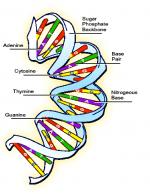|
This section contains 335 words (approx. 2 pages at 300 words per page) |
Gene theory is the idea that genes are the unit of inheritance. This theory has been modified many times over the years, as new evidence has become available. In the nineteenth century, Gregor Mendel, an Austrian monk, studied peas and how certain characteristics were transmitted from one generation to another. Mendel realized that the transmission was occurring through their gametes. He found that the adult plants contained two copies of a factor controlling the observed characteristic, but that the gametes only had the one copy.
In 1900, Mendel's work was rediscovered and reinterpreted. By this time chromosomes had been discovered and meiosis described. In the early part of the twentieth century, Thomas Morgan showed the relationship between the number of linkage groups in an organism and the number of chromosomes. Each of these inheritable factors were called genes. George Beadle and Edward Tatum proposed that one gene was responsible for the production of one enzyme (the one gene one enzyme theory). In the mid-twentieth century, Oswald Avery showed that DNA was the molecule carrying the genes. Edwin Chargaff worked out the constant relationship between the bases within DNA. In 1953, James Watson and Francis Crick worked out the structure of DNA along with its method of replication.
Because of these discoveries, scientists have been able to cut DNA with restriction enzymes and remove very precise sequences of DNA. This DNA can then be removed from one cell and placed into another. This is commonly carried out using bacteria as the recipient cell. This bacterium containing the new DNA can often be "tricked" into reading the DNA and making the product. This evidence is proof that genes are indeed the unit of inheritance and that the theory stating genes are responsible for the production of living organisms is largely correct. This is noted because many genes and their products do interact dramatically with the environment, and anything that we see is ultimately a product of the interaction of the organism's genes with its environment.
|
This section contains 335 words (approx. 2 pages at 300 words per page) |


